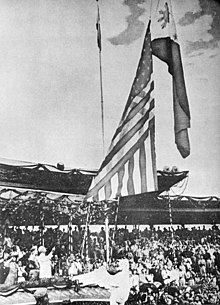Independence Day (Philippines)
From Wikipedia, the free encyclopedia
This article is about the national holiday. For the day the Philippines gained its independence from the United States, see Philippine Independence.
| Independence Day[1] Araw ng Kalayaan | |
|---|---|

Aguinaldo Shrine where Emilio Aguinaldodeclared the country's independence from Spain
| |
| Official name | Araw ng Kasarinlan |
| Also called | Araw ng Kalayaan Twelfth of June |
| Observed by | Philippines |
| Type | National |
| Significance | Declaring Philippine Independence from Spain |
| Date | June 12 |
| Next time | 12 June 2015 |
| Frequency | annual |
| Related to | Republic Day |
Independence Day (Filipino: Araw ng Kasarinlan; also Araw ng Kalayaan, lit. "Day of Freedom") is an annual national holiday in thePhilippines observed on June 12, commemorating the Philippine Declaration of Independence from Spain on June 12, 1898. It is the country's National Day.
History[edit]
Main article: History of the Philippines (1898–1946)
See also: Philippine Declaration of Independence
The Philippine Revolution began in August 1896. In December 1897, the Pact of Biak-na-Bato, an agreement between the Spanish colonial government and the revolutionaries, created a truce between the parties. Under terms of this agreement, Emilio Aguinaldoand other revolutionary leaders went into exile in Hong Kong.[2]
At the outbreak of the Spanish-American War, Commodore George Dewey sailed from Hong Kong to Manila Bay leading the Asiatic Squadron of the U.S. Navy. On May 1, 1898, the Dewey defeated the Spanish in the Battle of Manila Bay. Later that month, the U.S. Navy transported Aguinaldo back to the Philippines.[3]
On June 12, 1898, Aguinaldo led the declaration of Philippine independence from Spanish colonial rule. Philippines independence was not recognized either by the United States of America or by Spain. The Spanish government later ceded the Philippine archipelago to the United States in the 1898 Treaty of Paris. The Philippines Revolutionary Government did not recognize the treaty. When the Americans sought to execute the terms of the treaty, a three-year conflict, now called the Philippine-American War, ensued.[4][5]
The US granted independence to the Philippines on July 4, 1946 through the Treaty of Manila.[6]
July 4, the date chosen by the United States because it corresponds to its Independence Day, was observed in the Philippines asIndependence Day until 1962. On May 12, 1962, President Diosdado Macapagal issued Presidential Proclamation No. 28, which declared Thursday, June 12 a special public holiday throughout the Philippines, "... in commemoration of our people's declaration of their inherent and inalienable right to freedom and independence.[7]" On August 4, 1964, Republic Act No. 4166 renamed July 4 holiday as "Philippine Republic Day", proclaimed June 12 as "Philippine Independence Day", and enjoined all citizens of the Philippines to observe the latter with befitting rites.[8]
Prior to 1964, June 12 had been observed as Flag Day, which was moved to 28 May (the date the Philippine Flag was first flown in battle in Alapan, Imus, Cavite in 1898).


















.jpg)





.jpg)


.jpg)
